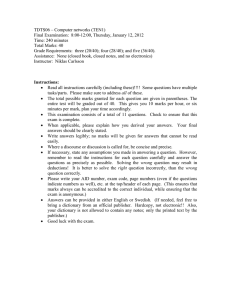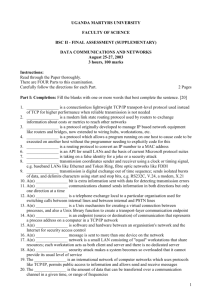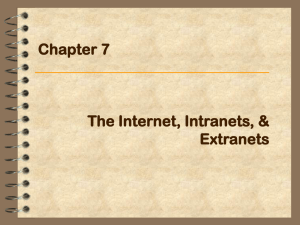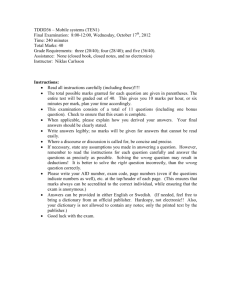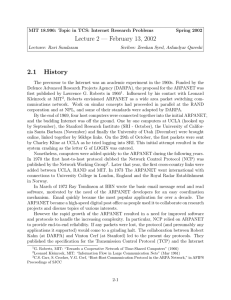EXAMPLE QUESTIONS (SINCE FIRST EXAM) Final Examination: SOME DATE
advertisement
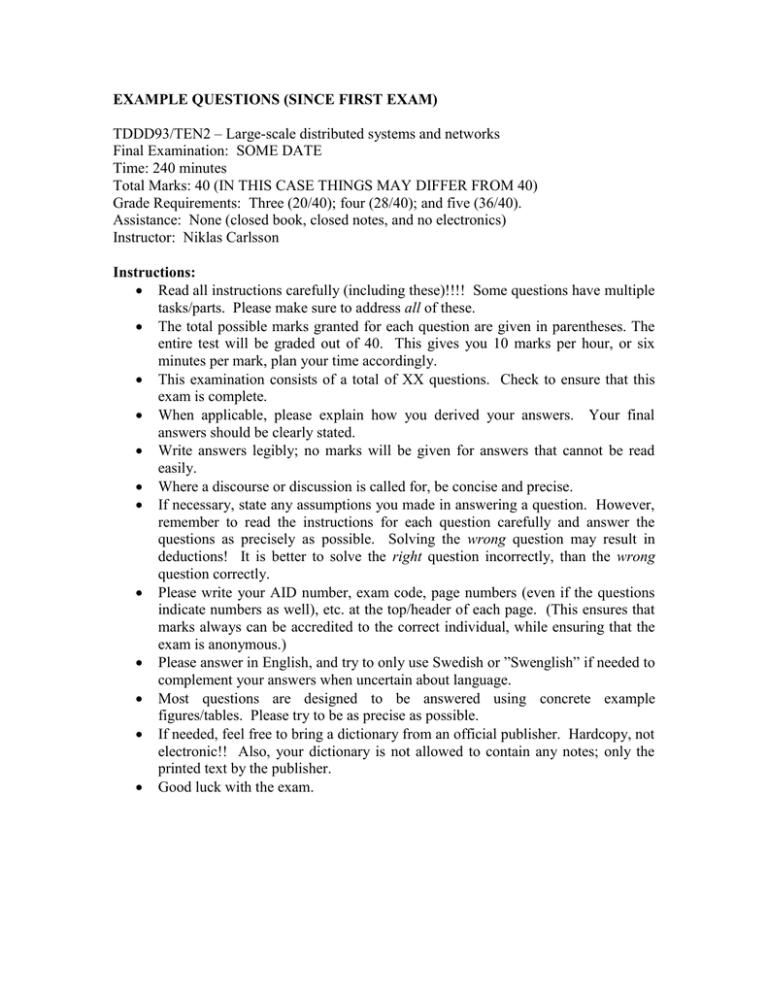
EXAMPLE QUESTIONS (SINCE FIRST EXAM) TDDD93/TEN2 – Large-scale distributed systems and networks Final Examination: SOME DATE Time: 240 minutes Total Marks: 40 (IN THIS CASE THINGS MAY DIFFER FROM 40) Grade Requirements: Three (20/40); four (28/40); and five (36/40). Assistance: None (closed book, closed notes, and no electronics) Instructor: Niklas Carlsson Instructions: Read all instructions carefully (including these)!!!! Some questions have multiple tasks/parts. Please make sure to address all of these. The total possible marks granted for each question are given in parentheses. The entire test will be graded out of 40. This gives you 10 marks per hour, or six minutes per mark, plan your time accordingly. This examination consists of a total of XX questions. Check to ensure that this exam is complete. When applicable, please explain how you derived your answers. Your final answers should be clearly stated. Write answers legibly; no marks will be given for answers that cannot be read easily. Where a discourse or discussion is called for, be concise and precise. If necessary, state any assumptions you made in answering a question. However, remember to read the instructions for each question carefully and answer the questions as precisely as possible. Solving the wrong question may result in deductions! It is better to solve the right question incorrectly, than the wrong question correctly. Please write your AID number, exam code, page numbers (even if the questions indicate numbers as well), etc. at the top/header of each page. (This ensures that marks always can be accredited to the correct individual, while ensuring that the exam is anonymous.) Please answer in English, and try to only use Swedish or ”Swenglish” if needed to complement your answers when uncertain about language. Most questions are designed to be answered using concrete example figures/tables. Please try to be as precise as possible. If needed, feel free to bring a dictionary from an official publisher. Hardcopy, not electronic!! Also, your dictionary is not allowed to contain any notes; only the printed text by the publisher. Good luck with the exam. TDDD93/TEN2 – Large-scale distributed systems and networks Final Exam: SOME DATE Part A: Background Theory Some example questions ... Question X (4 points) Consider a scenario in which you view a video on the YouTube website. Assume that the video is served from a datacenter located in eastern USA and you are located on the LiU campus. Furthermore, consider the IPv4 packets associated with the video transfer, including both requests and video content. Please draw an image of the end-to-end data path and briefly (but clearly!) explain using this figure how the following five addresses are used to achieve end-to-end Internet routing of the packets: (i) your IP address, (ii) your MAC address, (iii) the YouTube host name, (iv) Google’s AS number, and (v) LiU’s AS number. Question X (4 points) An end host must be able to learn about other computers’ and routers’ IP addresses and MAC addresses. Please explain how and with help of which protocols an end host (such as your computer) can learn these addresses. Also, please show the packet header information for an IPv4 packet from your computer to the above YouTube server when it passes your network interface card. The image should clearly label all MAC addresses, IP addresses, and port numbers inside of this packet and an explanation how they were obtained by the client. Question X (4 points) TCP congestion control often results in a saw-tooth pattern. Please explain why this sawtooth pattern occurs and leverage it to derive a proportionality expression for the throughput as a function of the round-trip time (RTT) and loss rate (L) of a connection. Question X (4 points) Use figures and examples to illustrate why TCP’s additive increase and multiplicative decrease (AIMD) mechanism provides some stability and fairness. Question X (4 points). Please compare and contrast (i) distance vector routing protocols for intra AS routing, (ii) link state routing protocols for intra AS routing, and (iii) inter AS routing protocols. Please draw an image and both carefully and concisely explain where along the end-toend path each type of protocol is likely to be used, and how the protocols together determine the path of an end-to-end internet packet. Question X (4 points). 2 TDDD93/TEN2 – Large-scale distributed systems and networks Final Exam: SOME DATE Please draw a figure that clearly shows an example where BGP may result in a suboptimal routing path and use the figure to explain why BGP would result in a sub-optimal route in this case. Question X (4 points). In class we talked a little bit about control plane and data plane, as well as both active and passive measurements. Please explain how traceroutes and BGP announcements can be used to understand the internet topology. Question X (4 points). The node degree distribution in both social networks and the internet topology has been found to be heavy tailed. Please explain how a heavy tailed distribution relates to an exponential distribution and support your answer with a plot of some well selected example distributions. Part B: Research Papers Some example questions ... Question X (4 points) Use a figures and example numbers to illustrate how cubic TCP differs from TCP Reno under some example scenario. Your example scenario should illustrate all phases of a typical TCP connect and should cover the initial both the handshake phase, as well as loss events detected using both duplicate ACKs and timeouts. Finally, using one sentence per bullet, list and briefly explain three additional TCP enhancements that are observed “in the wild” or in the context of “multi-path TCP”. Question X (4 points) Both HAS and TCP adapt the bandwidth usage based on current network conditions. First, compare and contrast the (i) target buffers and (ii) rate adaption algorithms of (a) Netflix, (b) Smooth Streaming, and (c) OSMF. Second, discuss how the rate adaption algorithms of HAS may reduce the fairness that TCP typically is able to achieve for longduration flows. (Try to concretize these answers using figures.) Question X (4 points) Network topologies generated through measurements are often incomplete. Oliviera et al. discusses how hidden and invisible links may affect the measured topology. First, use a figure and concrete example to explain the difference between these two types of links. Second, explain how common route announcement policies can result in invisible links. Here, you are expected to draw a figure that illustrate a scenario where one AS typically would be invisible to another AS due to the prefix announcements being propagated. 3 TDDD93/TEN2 – Large-scale distributed systems and networks Final Exam: SOME DATE Question X (4 points) In this course we have seen many examples of heavy-tailed distributions. Please list at least five papers and describe at least one heavy-tailed distribution from each of these papers. Sketch how you would illustrate these distributions and how you would expect them to lock in a plot. Question X (4 points) Use the literature from the course to explain (i) how modern websites are built up, (ii) who deliver this content, and (iii) how parallelism typically is achieved. This parallelism has both performance and privacy implications. Please describe these implications using a simple but concrete example scenario, ideally using a figure or two. Question X (4 points) A few of the papers that we have considered have observed time-of-day effects. Within the contexts of these papers, please describe time-of-day effects when discussion packet inter-arrival times, session durations, and any other workload- or application-related data. Please use example figures to illustrate and exemplify these time-of-day effects. Bonus (only on original exam) Bonus Question: XXXX (4) Leveraging concepts learned during the course (e.g., such as CCN, IoT, SDN, NFV) please describe and motivate what you believe is the most important network challenges to deliver future services over the internet. Please try to use as concrete use case(s) as possible. Good luck!! 4
